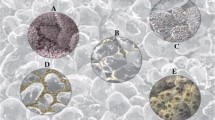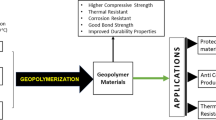Abstract
In order to develop high-performance water-based drilling fluid with the aim of meeting the increasing requirement of drilling industry, highly inhibitive and high-temperature-resistant shale inhibitors are essential. In this study, 4, 4′-methylenebis-cyclohexanamine was introduced as a potential shale inhibitor. The inhibitive properties of the amine compound in comparison with currently available polyether diamine inhibitor were evaluated using bentonite inhibition test, shale cuttings hot-rolling dispersion test, linear swelling test, and pressure transmission test. The inhibitive mechanism was investigated with zeta potential measurement, X-ray diffraction analysis, and contact angle measurement. The results indicated that 4, 4′-methylenebis-cyclohexanamine can inhibit shale hydration and dispersion effectively, and prevent pressure transmission to a certain extent, performing better than that of polyether diamine. Furthermore, the new diamine provides reliable thermal stability as high as 220 °C, preserving the benefits of high-temperature wells application. This novel diamine inhibits shale hydration and dispersion with the combination of chemical inhibition and physical plugging. The intercalation into the interlayer of clay with monolayer collapses the hydrated clay structure and expels the water molecules. After adsorption, clay surface became more hydrophobic, which prevents the imbibition of water. The variation of solubility separates the compound from the solution, which can plug the micro-pores of shale and prevent fluid invasion.












Similar content being viewed by others
References
Chen G, Chenevert ME, Sharma MM, Yu M (2003) A study of wellbore stability in shales including poroelastic, chemical, and thermal effects. J Pet Sci Eng 38(3–4):167–176
Zeynali ME (2012) Mechanical and physic-chemical aspects of wellbore stability during drilling operations. J Pet Sci Eng 82:120–124
Shadizadeh SR, Moslemizadeh A, Dezaki AS (2015) A novel nonionic surfactant for inhibiting shale hydration. Appl Clay Sci 118:74–86
Zhong H, Qiu Z, Huang W, Sun D, Zhang D, Cao J (2015) Synergistic stabilization of shale by a mixture of polyamidoamine dendrimers modified bentonite with various generations in water-based drilling fluid. Appl Clay Sci 114:359–369
Van Oort E (2003) On the physical and chemical stability of shales. J Pet Sci Eng 38(3):213–235
Caenn R, Chillingar GV (1996) Drilling fluids: state of the art. J Pet Sci Eng 14:221–230
Patel A, Stamatakis E, Young S, Cliffe S (2002) Designing for the future: a review of the design, development and testing of a novel, inhibitive water-based drilling fluid. In: AADE-02-DFWM-HO-33, AADE 2002 Technical Conference, Texas, 2–3 April
Gomez S, Ke M, Patel A (2015) Selection and application of organic clay inhibitors for completion fluids. In: SPE 173731. SPE International Symposium on Oilfield Chemistry, Texas, 13–15 April
Schlemmer R, Patel A, Friedheim J, Young S, Bloys B (2003) Progression of water-based fluids based on amine chemistry—can the road lead to true oil mud replacements? In: AADE-03-NTCE-36, AADE 2003 National Technology Conference, Texas, 1–3 April
Patel A, Stamatakis E, Young S, Friedheim J (2007) Advances in inhibitive water-based drilling fluids—can they replace oil-based muds? In: SPE 106476, SPE International Symposium on Oilfield Chemistry, Texas, 28 Feb–2 March
Balaban RDC, Vidal ELF, Borges MR (2015) Design of experiments to evaluate clay swelling inhibition by different combinations of organic compounds and inorganic salts for application in water base drilling fluids. Appl Clay Sci 105:124–130
Suter JL, Coveney PV, Anderson RL, Greenwell HC, Cliffe S (2011) Rule based design of clay-swelling inhibitors. Energy Environ Sci 4:4572–4586
Hodder M, Cliffe S, Greenwell C, Williams P, Coveney P (2010) Clay Swelling inhibitors-computer design and validation. In: AADE-10-DF-HO-32, AADE Fluids Conference and Exhibition, Texas, 6–7 April
Mao H, Qiu Z, Shen Z, Huang W (2015) Hydrophobic associated polymer based silica nanoparticles composite with core-shell structure as a filtrate reducer for drilling fluid at ultra-high temperature. J Pet Sci Eng 129:1–14
Zhao C, Tong K, Tan J, Liu Q, Wu T, Sun D (2014) Colloidal properties of montmorillonite suspensions modified with polyetheramine. Coll Surf A 457:8–15
Shan W, Tao S, Fu F, Yue W, Zhao Z (2014) Research on the drilling fluid technology for high temperature over 240°C. Proced Eng 73:218–229
Zhong H, Sun D, Huang W, Liu Y, Qiu Z (2015) Effect of cycloaliphatic amine on the shale inhibitive properties of water-based drilling fluid. Open Fuels Energy Sci J 8:19–27
An Y, Jiang G, Ren Y, Zhang L, Qi Y, Ge Q (2015) An environmental friendly and biodegradable shale inhibitor based on chitosan quaternary ammonium salt. J Pet Sci Eng 135:253–260
Khodja M, Canselier JP, Bergaya F, Fourar K, Khodja M, Cohaut N, Benmounah A (2010) Shale problems and water-based drilling fluid optimization in the Hassi Messaoud Algerian oil field. Appl Clay Sci 49:383–393
Zhang S, Qiu Z, Huang W, Cao J, Luo X (2013) Characterization of a novel aluminum-based shale stabilizer. J Pet Sci Eng 103:36–40
Liu J, Qiu Z, Huang W (2015) Novel latex particles and aluminum complexes as potential shale stabilizers in water-based drilling fluids. J Pet Sci Eng 135:433–441
Zhong H, Qiu Z, Zhang D, Tang Z, Huang W, Wang W (2016) Inhibiting shale hydration and dispersion with amine-terminated polyamidoamine dendrimers. J Nat Gas Sci Eng 28:52–60
Alemdar A, Güngör N (2005) The rheological properties and characterization of bentonite dispersions in the presence of non-ionic polymer PEG. J Mater Sci 40:171–177. doi:10.1007/s10853-005-5703-4
Moslemizadeh A, Shadizadeh SR, Moomenie M (2015) Experimental investigation of the effect of henna extract on the swelling of sodium bentonite in aqueous solution. Appl Clay Sci 105–106:78–88
Abu-Jdayil B (2011) Rheology of sodium and calcium bentonite–water dispersions: effect of electrolytes and aging time. Int J Miner Process 98(3–4):208–213
Luckham PF, Rossi S (1999) The colloidal and rheological properties of bentonite suspensions. Adv Colloid Interface Sci 82(1–3):43–92
Kelessidis VC, Christidis G, Makri P, Hadjistamou V, Tsamantaki C, Mihalakis A, Papanicolaou C, Foscolos A (2007) Gelation of water–bentonite suspensions at high temperatures and rheological control with lignite addition. Appl Clay Sci 36:221–231
Amanullah M, Al-Arfaj M, Al-Ansari A (2015) Method for prediction of inhibition durability index of shale inhibitors and inhibitive drilling mud systems. US 9164018
Ewy RT, Morton EK (2009) Wellbore-stability performance of water-based mud additives. SPE Drill Complet 24(3):390–397
Wang L, Liu S, Wang T, Sun D (2011) Effect of poly(oxypropylene)diamine adsorption on hydration and dispersion of montmorillonite particles in aqueous solution. Coll Surf A 381(1–3):41–47
Lin JJ, Chen YM, Yu MH (2007) Hydrogen-bond driven intercalation of synthetic fluorinated mica by poly(oxypropylene)-amidoamine salts. Coll Surf A 302(1–3):162–167
Takahashi T, Yamada Y, Kataoka K, Nagasaki Y (2005) Preparation of a novel PEG-clay hybrid as a DDS material dispersion stability and sustained release profile. J Control Release 107(3):408–416
Yalçin T, Alemdar A, Ece ÖI, Güngör N (2002) The viscosity and zeta potential of bentonite dispersions in presence of anionic surfactants. Mater Lett 57(2):420–424
Duman O, Tunç S, Çetinkaya A (2012) Electrokinetic and rheological properties of kaolinite in poly(diallyldimethylammonium chloride, poly(sodium 4-styrene sulfonate) and poly(vinyl alcohol) solutions. Coll Surf A 394:23–32
Wang J, Liu G, Wang L, Li C, Xu J, Sun D (2010) Synergistic stabilization of emulsions by poly(oxypropylene) diamine and laponite particles. Coll Surf A 353(2–3):117–124
Mohan KK, Fogler HS (1997) Effect of pH and layer charge on formation damage in porous media containing swelling clays. Langmuir 13:2863–2872
Ritter AJ, Geraut R (1985) New optimization drilling fluid programs for reactive shale formations. In: SPE 14247, 60th Annual Technical Conference and Exhibition of the Society of Petroleum Engineers, Las Vegas. 22–25 Sept
Zhong H, Qiu Z, Huang W, Cao J (2011) Shale inhibitive properties of polyether diamine in water-based drilling fluid. J Pet Sci Eng 78:510–515
Siguín D, Ferreira S, Froufe L, Garcia F (1993) The relationship between isomorphic substitutions and swelling in montmorillonites. J Mater Sci 28:6163–6166. doi:10.1007/BF00365038
Lu S, Chung DDL (2014) Effect of organic intercalation on the viscoelastic behavior of clay. J Mater Sci 49:3189–3195. doi:10.1007/s10853-014-8022-9
Zaltoun A, Berton N (1992) Stabilization of montmorillonite clay in porous media by high-molecular-weight polymers. SPE Prod Eng 7(2):160–166
An Y, Jiang G, Qi Y, Ge Q, Zhang L, Ren Y (2015) Synthesis of nano-plugging agent based on AM/AMPS/NVP terpolymer. J Pet Sci Eng 135:505–514
Akhtarmanesh S, Ameri Shahrabi MJ, Atashnezhad A (2013) Improvement of wellbore stability in shale using nanoparticles. J Pet Sci Eng 112:290–295
Mittal V (2008) Effect of the presence of excess ammonium ions on the clay surface on permeation properties of epoxy nanocomposites. J Mater Sci 43:4972–4978. doi:10.1007/s10853-008-2732-9
Acknowledgements
This work was financially supported by National Science Foundation of China (Nos. 51374233 and 51474236), Application and basic research Project of Qingdao (15-9-1-43-jch), and the Fundamental Research Funds for the Central Universities (16CX02023A).
Author information
Authors and Affiliations
Corresponding author
Ethics declarations
Conflict of interest
The authors declare that they have no conflict of interest.
Rights and permissions
About this article
Cite this article
Zhong, H., Qiu, Z., Tang, Z. et al. Study of 4, 4′-methylenebis-cyclohexanamine as a high temperature-resistant shale inhibitor. J Mater Sci 51, 7585–7597 (2016). https://doi.org/10.1007/s10853-016-0037-y
Received:
Accepted:
Published:
Issue Date:
DOI: https://doi.org/10.1007/s10853-016-0037-y




